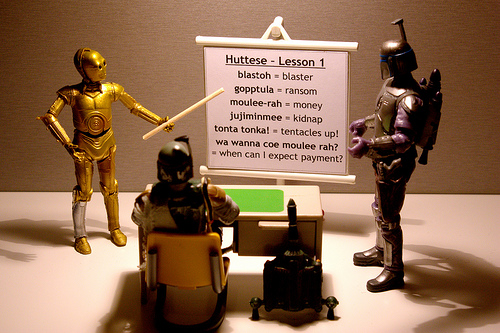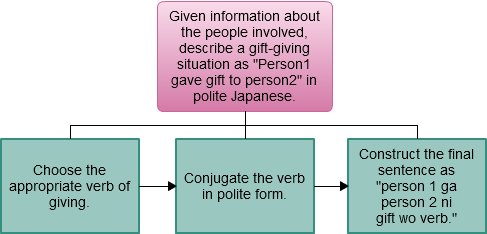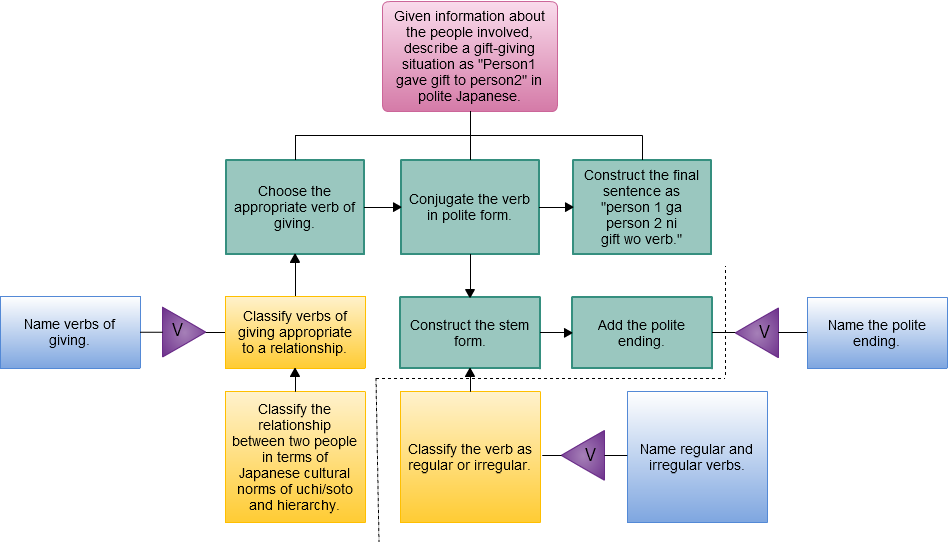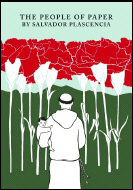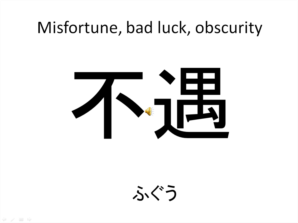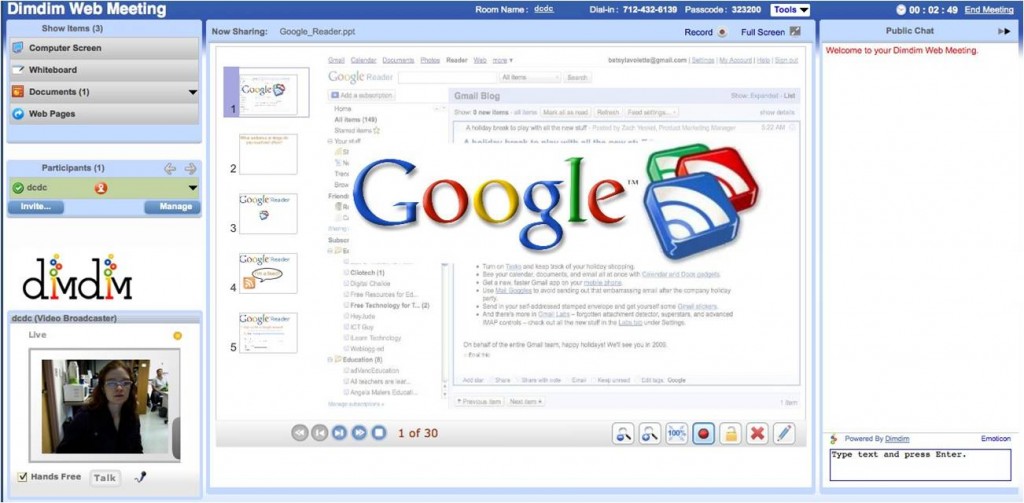Student again!
PhD student now. Too busy to blog!
But now that I am back in school, I have a profile page to share.
Enjoy!
SDoI: Chapter 5: Analyzing Learners and Contexts
[This is the sixth in a series of posts about Dick and Carey’s The Systematic Design of Instruction. Want to read an overview and my thoughts on Chapter 1, Chapter 2, Chapter 3, and Chapter 4 before proceeding?]
This chapter is about characterizing learners, the context in which they will be performing, and the context in which they will be learning.
Bounty Hunting School – Language Course by Stéfan 
Learners
This chapter tells us that we need to know certain characteristics of the targeted learners. But what is the purpose of gathering that information? How will it affect the instruction that is later developed? If the learners do not have skills that you initially considered entry behaviors, you can directly use that information to design instruction that includes more basic skills. However, why do we need to know about gender, for example? Will knowing that learners have positive attitudes toward the content change the way that the instruction is designed? More information on this topic is apparently found in later chapters, according to p. 90:
In this chapter, we identify a set of variables that research has indicated affects learning. If you describe your learners in terms of these variables, you can modify your instructional strategy to enhance learning.
So, information on specific variables will directly impact the learning design. We just don’t yet know how they will impact it. Here are those variables, from p. 91:
- Entry behaviors
- Prior knowledge of the topic area
- Attitudes toward content and potential delivery systems
- Academic motivation
- Educational and ability levels
- General learning preferences
- Attitudes toward the organization giving the instruction
- Group characteristics
I wonder about #7, since this could be a loaded question. How can you get an honest answer? Also, I am not sure that this is relevant to, for example, college students who are studying a foreign language at a particular institution. Should the design of the instruction be changed if the students hate their university? Or if they love it?
Performance context
The listed characteristics of the performance environment (pp. 93-94) are
- Managerial or supervisor support
- Physical aspects of the site
- Social aspects of the site
- Relevance of skills to workplace
But what is the performance context for foreign language learners? Various work, school, and social settings in the foreign-language culture? A home stay? A workplace in the United States? Only the classroom? There are simply too many possibilities. My opinion is that this should be moved to the learner characteristics in this case. We cannot know how the learners plan to use their language skills unless we ask them. But will this affect the instruction that is created? Only, I think, if it affects the instructional goals.
Learning context
The listed characteristics of the learning environment (p. 95) are
- Adaptability of site to simulate workplace
- Adaptability for delivery approaches
- Learning-site constraints affecting design and delivery
In universities, the instructor or instructional designer may not know what classroom space will be available or assigned, which complicates any investigation of the learning context.
The third characteristic is very important to consider if the instruction includes any technology, even that as basic as chalkboards. The classroom itself may limit what type of instruction is possible.
Evaluation and revision of the instructional analysis
Tacked onto the end of this chapter is a recommendation to have your instructional analysis evaluated by learners before proceeding to the next step. From p. 97,
The reason we are discussing the tryout in this chapter, rather than in the last one, is that the tryout can occur at the same time the designer is conducting the learner and context analyses. Those analyses bring the designer into contact with potential learners, or recent learners, who can review the instructional analysis with the designer.
Ah, great idea! Rather than relying on your own intuitions about steps and skills and entry behaviors, you can get an informant to check out your ideas and get feedback before proceeding.
Next up: Chapter 6, Writing Performance Objectives.
SDoI: Chapter 4: Identifying Subordinate Skills and Entry Behaviors
[This is the fifth in a series of posts about Dick and Carey’s The Systematic Design of Instruction. Want to read an overview and my thoughts on Chapter 1, Chapter 2, and Chapter 3 before proceeding?]
It’s been a while (okay, more than a year) since I posted about the previous chapter, but I have not given up!
Chapter 4 is about how to further analyze an instructional goal by determining subordinate skills and entry behaviors. I found this idea interesting, so I tried it out on an example language goal: “Given information about the people involved, describe a gift-giving situation as ‘Person1 gave gift to person2’ in polite Japanese.” By information, I mean the relative ages of the people, their relationship (friends, teacher/student, parent/child, etc.), etc. Here is a simple diagram of the steps that I believe are involved.
I simplified the situation by providing a framework for the sentence where the verb and three nouns can be plugged in, rather than adding steps in which the sentence is constructed. Those steps could be added before the verb steps.
So, back to the text to learn how to analyze the subordinate skills.
On p. 54, we learn that
The hierarchical approach is used to analyze goals that are classified as intellectual or psychomotor skills.
Although this goal requires plenty of verbal information, I think that it can be usefully classified as an intellectual skill. So, I will try a hierarchical analysis.
How is hierarchical analysis done? Also on p. 54,
The hierarchical analysis technique suggested by Gagné consists of asking the question, “What must the student already know so that, with a minimal amount of instruction, this task can be learned?”
And on p. 58,
One way to proceed is to ask, “What mistake might students make if they were learning this particular subordinate skill?”
Further information is provided on pp. 58-59.
You should also ask the following questions:
- Have I included subskills that relate to the identification of basic concepts, such as objects or object qualities? (Example: Can a tetrahedron be identified?)
- Have I included subskills that enable students to identify abstractions by means of a definition? (Example: Can the student explain what a city is, or show what an emulsion is?)
- Have I included subskills that will enable students to apply rules? (Example: Making sentence verbs agree with subjects, simplifying mixed fractions.)
- Have I included subskills in the analysis that will enable students to learn how to solve problems required to demonstrate mastery of the instructional goal?
I tried to incorporate these questions into my subordinate analysis, and I used the information on creating instructional analysis diagrams on pp. 62-64 to construct the following:
Just for visual clarity, I made steps green, subskills yellow, and verbal information blue. One problem that I had with making the diagram was that my third step (“Construct the final sentence…”) requires verbal information, such as knowing the Japanese words for various pronouns and other nouns that represent the gift. But none of the examples in the book show verbal information being connected directly to a step. It is always connected to a subskill, so I am not sure if it is okay to add it to a step.
The subskills could be taken further, but I think that I have already defined some that I consider entry behaviors. In the glossary (p. 346), “entry behaviors” are defined as
Specific competencies or skills a learner must have mastered before entering a given instructional activity.
I would designate the entry behaviors for this goal as everything below and to the right of the dotted line. In other words, students should already know some regular and irregular verbs and the polite ending before learning this goal.
So, that is my attempt to apply this chapter to a very specific language goal.
One other comment on this chapter: One of the examples of a cluster analysis struck me as a terrible way to organize information. While hierarchical analysis is used for intellectual goals, cluster analysis is used for verbal information. The glossary (p. 345) defines “cluster analysis” as
A technique used with goals in the verbal information domain to identify the specific information needed to achieve the goal and the ways that information can best be organized or grouped.
So, why in the world would you organize anatomy vocabulary as lists of words, as the books shows on p. 87? Wouldn’t the best, most intuitive way to organize it be as labels on a drawing of a body?
Learning vocabulary using Rikaichan and Google News
One of my frustrations as a learner of Japanese has always been the amount of time lost to looking up unknown kanji. By the time I have found the right reading and the right word, I’ve forgotten what the surrounding context was, and I have to reread the sentence or paragraph. Online dictionaries certainly help with this since you can copy and paste a word and get an answer quickly, but it still involves switching to a different website, checking the meaning, then returning to the original context.
Rikaichan solves this problem. It’s a plugin for Firefox that pops up a box with the readings of Japanese words and their meanings in English (or another language of your choice). I highly recommend it for any learner of Japanese. (And for translators as well–it is helping me learn the readings of words that I previously only knew the meanings of.)
I was recently using Rikaichan to assist me in reading Google News in Japanese, and I was focused on learning more about the recent volcanic eruption in Iceland. As I read article after article on the same topic and even watched a few videos, I saw and heard some of the same key terms over and over. For example, 火山灰 (volcanic ash), 噴火 (eruption), 閉鎖 (closure), and 欠航 (flight cancellation) kept appearing. And after a few repetitions, I knew both the pronunciation and the meaning without the pop up!
So, vocabulary was organically recycled in this authentic input. I am certainly not the first person to realize the potential of Google News for vocabulary learning, but I am excited to use it more myself and think about how it could be incorporated into the language classroom and my research.
New theme
My site got hacked recently, so I’ve taken this as an opportunity to revamp the theme. I’ve customized the graphics, including my own business card on the lower right!
Here’s what to do if your WordPress site ever gets hacked.
Goodbye, 2010. Welcome, 2011!
Working via the Internet defined 2010 for me. Although I wore many different hats as an independent contractor, all of them allowed me to do almost all of my work from my computer, here in Indiana or from various other places I traveled during the year. A couple of highlights:
- I began working as a Japanese-to-English translator for YKS Services. I mainly work with medical and pharmaceutical documents, although I have also branched out into the legal and engineering fields.
- I contracted with ACTFL as a Blackboard/web 2.0 specialist. We are creating online courses and resources for language teachers.
Working from home gave me the flexibility to also spend time on other projects, including applying for PhD programs. Here are the programs that made the cut:
- Second Language Acquisition and Teaching, University of Arizona
- Second Language Studies, Michigan State University
- Second Language Acquisition, University of Wisconsin-Madison
- Applied Linguistics and Technology, Iowa State University
- Instructional Technology, University of Texas at Austin
In my free time in 2010, I learned to knit and crochet, and I continued with my life-long interest in origami. Here are a few of my favorite craft projects from the year:
In 2011, I’m looking forward to
- traveling to San Fransisco, Tokyo, and at least one other international location that is TBD.
- my husband‘s graduation from his creative writing MFA program.
- deciding on a PhD program and beginning it.
- more crafting!
The People of Paper
We were lucky to have Salvador Plascencia come to the Notre Dame campus and read from The People of Paper on September 15. He was a very engaging speaker, and quite personable at the party afterward, as well. Because of this, our book club chose his book for our discussion yesterday. I really loved it! It is probably the most original book I have ever read.
Oddly enough, I could not find any discussion questions online, so here are the ones I wrote. Feel free to add more in the comments.
Spoilers below…
- Why does the author choose to represent himself as Saturn, rather than any other heavenly body?
- Why a war on Saturn? That is, why does EMF specifically choose Saturn to fight? What do they think they will gain from it? Why do they think he is their enemy? How is it that they believe in both a Catholic god and Saturn?
- What do the mechanical tortoises represent?
- Which “facts” are untrue? For example, can eating too many limes really kill you? Are there really people who get off on bee stings? Does living near lead (rather than ingesting it) cause nausea? What are the purposes of these “facts”?
- What do the drawings of the hands (in the table of contents and at the beginnings of sections) represent?
- Is Baby Nostradamus really able to see the future? Or is it just in the heads of other people?
- What does it mean that some characters (Baby Nostradamus and Little Merced) can block their thoughts from Saturn? How can the author not know what his characters are thinking?
- Do you think the author originally intended to write a different, less complex book that morphed into the published version after his breakup with Liz? Or was it planned as is from the start?
Language learning while knitting
I recently learned to knit and crochet, which you may have noticed if you follow me on Facebook or Ravelry (username: betsylavolette – let’s be friends!). It’s a great way to pass the time when you’re captive in a car, casually chatting with family, or watching a movie, but sometimes I get out those needles/hooks when there isn’t anything else going on. I wanted to study Japanese while I was knitting/crocheting, that is, listening and looking without any mouse clicking or typing (since my hands are fully occupied). Of course, I can listen to podcasts, but I also want to review vocabulary.
So, I created a PowerPoint with each slide as follows:
1. The word shows for 3 seconds in Japanese characters.
2. The word shows for 3 seconds with its meaning and reading (in furigana, Japanese phonetic characters), while a sound clip plays of the meaning and reading.
The slides play continuously, so I can glance up at the characters while I knit and listen. If I don’t look up at each slide, that’s okay because they will come back around. Each time I open the file, I can use a macro to randomize the slides – so I see them in a different order each time.
I’m including the PowerPoint file here so that you can use it as a template if you want to study your own list of words/language. When you open it, you will need to enable macros, then run the “shufflerange” macro if you want to randomize the slides. The audio clips are my own voice, so be aware that the Japanese is not necessarily native-like! The vocabulary words are taken from a children’s edition of The Tale of Genji, so they may strike you as somewhat archaic.
The next thing I’d like to try is making this a web app that can run in standard browsers and mobile Safari (for the iPhone). Any suggestions for me?
CALICO 2010: Great conference, or the greatest conference?
The Computer Assisted Language Learning Consortium Conference 2010 was in Amherst, MA, June 10 – 12. I summed up my feelings about it in this tweet:
Goodbye, #calico2010! It was awesome, in terms of presentations, people, planning, place…
Presentations
I learned so much from the sessions! This was the first conference I’ve attended where I have gone to a presentation during every session – despite being tired, I did not want to miss a minute! Everything will be online soon (at the CALICO site), I believe, and I will look forward to seeing the ones I missed.
Here are some of the (free) resources that I gathered.
- revMedia: Free application for developing web apps in a simplified programming language. This looks promising! However, viewing the apps requires a plugin that doesn’t seem to work on Firefox.
- LORO: From the Open University, a collection of online language materials: French, Spanish, German, ESL, Chinese, and even Welsh!
- XENOS: A virtual island where with games to learn English, Spanish, or Chinese. Currently, it’s in alpha testing, and I can’t seem to try it myself yet. The demos were impressive!
- Façade: A bizarre interactive drama, where you try to help (or hinder) a couple that is going through marital difficulties. Fascinating idea!
- The REALIA Project: An archive of images that are free to use for educational purposes. Many of them include suggestions for using them in the language classroom, such as this Japanese lunch special that can be used to practice terms for counting.
- Voxopop: Audio discussion board.
- Forvo: Crowdsourced pronunciations of words in an incredible number of languages.
- FLAn: An editor for creating annotated texts. The exercises you can create using it are useful for learners, especially in combination with quizzes made in Hot Potatoes.
People
What a friendly group! I met so many incredibly nice, intelligent, informed, helpful people at the conference, not to mention the ones I knew already. Thanks to Facebook and Twitter, I’m looking forward to keeping in touch with many of them. And keeping in touch is important since we have the Adult Beverage Special Interest Group to plan for next year!
Planning
Everything went so smoothly – which means that endless hours were spent behind the scenes so that I could simply enjoy. Thank you, CALICO organizers!
Place
Amherst College is a beautiful setting and just a short walk from downtown Amherst, with its locally owned shops and restaurants. The dorm room I stayed in was nicer than my apartment, and it was right next to the buildings where the sessions were held. Perfect!
And so…
I can’t wait for CALICO 2011: May 17-21 at the University of Victoria. See you there?
Dimdim vs. Elluminate, Round 2
Several people have written to ask me for a copy of the paper I allude to in Dimdim vs. Elluminate: Fight!
Well, the status of that paper has been “in press” since it was accepted by TechTrends in December 2009. I was hoping to wait until it was “officially” published in TechTrends before publishing it here, but that journal does not seem to have a grasp on the time-sensitivity of the information it publishes – despite its name. The journal editors also have not responded to my emails inquiring about when we can expect to see our manuscript in print. *Sigh*
So, without further ado, here is a preprint version in PDF format:
Lavolette, E., Venable, M., Gose, E., & Huang, P. (in press). Comparing synchronous virtual classrooms: Student, instructor and course designer perspectives. Tech Trends.
[Update: This was published in 2010.]

